Just like ornaments, a fancy dupatta also completes a women’s outfit. Designer dupatta adds the much-needed charm to an ethnic look. Heritage dupattas are a vital component of ethnic clothing. Women have worn Indian dupattas for generations out of dignity and modesty. Over time old Indian dupatta’s variety, purpose and usage have changed, and now it has become more of a fashion statement. Stylish dupattas for women are a crucial component of every woman's ethnic outfit.
Indian dupatta is a wardrobe necessity because it can instantly glam up your clothing. India offers a wide variety of handlooms and antique fabrics from which Indian Heritage Women's dupatta can be made. And these dupattas have been popular for their comfort and appearance for years! In this manner, a well-known historic dupatta's worth is sustained over time.
In the past, Indian dupattas served as a clothing item representing a woman's modesty. Dupattas have come a long way, from the reasons for wearing them to their many variations. The way that dupattas are worn has changed over time. The dupatta has gained popularity among South Asian women outside of India. While most fashion trends become popular over time and stay for two to three years, the trend of dupattas continues to maintain its popularity and identity for years.
Usually, the dupatta length is several feet long and wrapped across your head or shoulder. Majorly it is used to cover the upper body; different ways to style a dupatta have come to light. They are used as complementary pieces of clothing with other apparel items.
They may occasionally be worn for religious purposes too. For covering your head, most of the main world faiths have specific guidelines. In places of worship such as temples, covering one's head with a dupatta is appropriate for ladies.
Which City is Famous for Indian Dupattas
India is a land for a variety of textiles with every region having its own designs and handicrafts. Indian dupattas from every corner of the country have a special place in your wardrobe. Several cities in India are famous for different types of stylish dupattas for women.
Old Indian dupattas like Banarasi dupatta are a masterpiece from the city of Varanasi also known as Benaras. If you are a movie lover you cannot miss the charm of this 1990s dupatta worn by several actresses in movies. Kantha work from West Bengal is revered for its artistic designs. You can find the best kantha-stitch dupattas in Kolkata and its surrounding areas.
Punjab is the land of phulkari. The floral embroidery on fabric has been popular among the ladies for ages. The charm of old Indian dupatta designs is unmissable. You can find phulkari dupattas in local markets of Amritsar, Ludhiana, Patiala and more. The town of Chanderi in Madhya Pradesh is best known for Chanderi dupattas and sarees. If you want to recreate 1990s dupatta styles with flowing sheer dupattas you must check out Chanderi dupattas. Bandhani is an exquisite tie and dye technique for creating intricate patterns on fabrics. Jaipur, Surat, Ahmedabad, are some of the top cities to find best bandhani and ajrakh dupattas. Local markets in Jaipur are one of the best places to buy stylish dupattas for women at affordable prices.
However, to buy authentic handmade 1990s dupattas check out trusted sellers like iTokri who sources authentic products directly from the artisans.
Dupattas can be used as an article of clothing that adds the traditional touch to your entire ethnic outfit. Their texture, comfort and appearance usually depend on the material from which they have been made. A variety of Indian fabrics are used to curate them. A dupatta is a very adaptable item of apparel. It can be worn in various ways, with different dresses, and in various fashions. The plethora of patterns, hues, and decorations is bewildering regarding the dupatta.
They go with a variety of traditional Indian outfits. Many fabrics can be used to make a dupatta, including phulkari dupatta, banarasi dupatta, bandhani dupatta, silk dupatta, cotton dupatta, and many more. The embroidery on your chosen dupatta may be replicated or comparable on lehengas, dresses, sarees, and phulkari suits. Read on more to learn about traditional Indian dupattas.
Different Types of Indian Dupattas for Your Wardrobe
Known as chunari, choli, odhani and what not, dupattas are the pride and honour of Indian women even today. Here are the 14 most popular of them all -
-
Banarasi Dupatta - Banarasi silk is the most treasured craft of all times. Banarasi dupattas have attained much adoration and fascination in modern fashion statements - As the name implies, Banarasi dupattas are from Varanasi, Uttar Pradesh, a city renowned for its numerous beauties. The rich, robust zari work that oozes grandeur on Banarasi brocade sarees has always been a favourite feature of these garments. This authentic piece of clothing is a must-have in any women's wardrobe. The Mughal aristocracy wore Banarasi Silk, a prized skill at the time. The beautiful embroidery enhances the elegant design of the clothing on the luxurious silk designs. Give a touch of royalty to your outfit with banarasi dupattas. These Indian dupattas are appropriate for all kinds of festivities and is glitzy and luxurious!

2. Phulkari Dupatta - Standing out proudly as Punjab’s heritage dupatta, this one has a great splash of vibrant colours and embroidery - Geometric and floral designs are used to create phulkari dupattas. These 1990s dupattas give your appearance a playful and traditional appeal. People across the world are a fan of the highly detailed multicoloured needlework done on khadi, cotton, or silk fabrics. Everyone has been keen on adopting this look, from huge fashion icons to streetwear. The best thing about these dupattas is their versatility and adaptability. You can easily experiment with this dupatta with different outfits. Want to give your pastel suit a splash of colour? You won't regret purchasing this lovely dupatta made of phulkari!

3. Bandhani Dupatta - This ancient tie and dye art coming from the Rajasthani cultures is a favourite of all Indians now - Pure bandhani or bandhej dupattas are well-known in Rajasthan and Gujarat. Bandhani-style dupattas have a long history, and the method is thought to have originated with the Indus Valley Civilization. These are woven, coloured dupattas in a range of materials. The authentic mirror work technique is used to adorn bandhani dupattas. Sarees, dupattas, and outfits in the bandhani style are timeless. For formal meetings or festive occasions, a bandhani dupatta can be worn casually with a black or white Kurti making it a perfect choice for stylish dupattas for women.
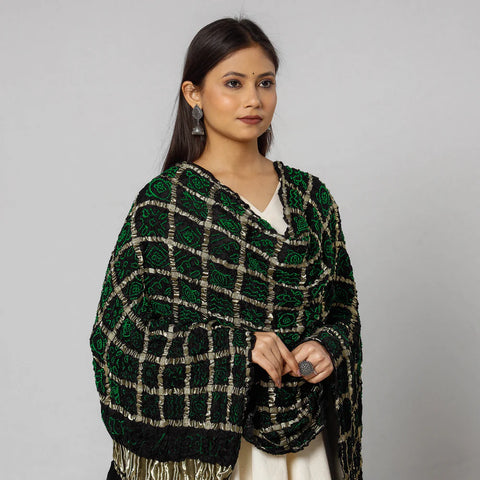
4. Chanderi Dupatta - Very lightweight and easy to carry, these heritage dupattas are made up of cotton or silk - They are famous for their elegance and simplicity and come from the little town of Chanderi in Madhya Pradesh. Chanderi dupattas are available in various fabrics, including cotton, silk, and others. Your collection of traditional dupattas must include cotton or silk chanderi dupattas. These dupattas are portable and lightweight. It is an excellent approach to giving plain ensembles a classic feel. Add spice to your outfit with a fantastic chanderi dupatta.
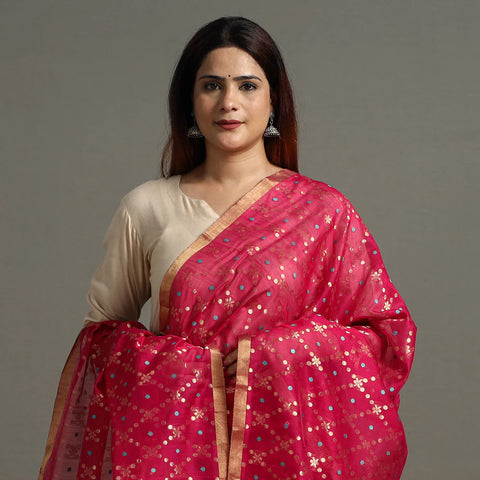
5. Kalamkari Dupatta - Hand-painted or block printed, these mangalkari cotton or cotton silk - Kalamkari is a distinctive art of Andhra Pradesh and Telangana, hand-painted or block-printed. While this traditional design is inspired by Persian culture, it has successfully created its presence The weavers are experts at this handpainted process, which demands a lot of time, accuracy, and patience. It features famous stories as well as floral, animal, and paisley designs. They are also fashionable in sarees and kalamkari dupattas.
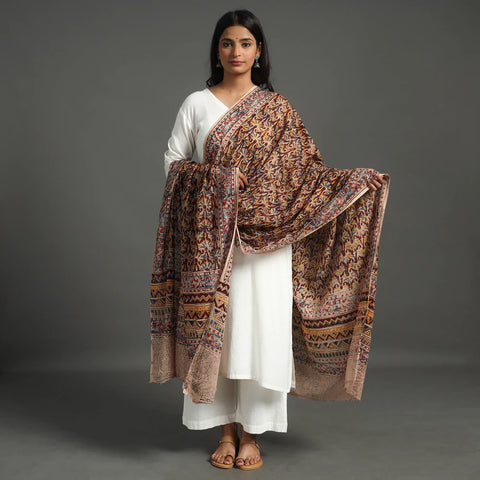
6. Ikat Dupattas - Famous for their colourful and blurry abstract patterns, these are known for their exceptional tying and dying yarn technique and then weaving it into a final fabric - Ikat is renowned for its vivid and hazy abstract designs! Its method of tying, dying, and weaving yarn into a finished fabric is fascinating. IKat is gaining popularity steadily. Apart from stylish dupattas for women, the Ikat technique is also used in sarees, blouses, dresses, and one-piece suits. It embodies bohemian style to the fullest extent. Our collection of Ikkat dupattas has been consistent and up to date with current fashion trends. We have ikkat pattu dupattas, which can be hand-printed or decorated with various arts to make the user look her best.
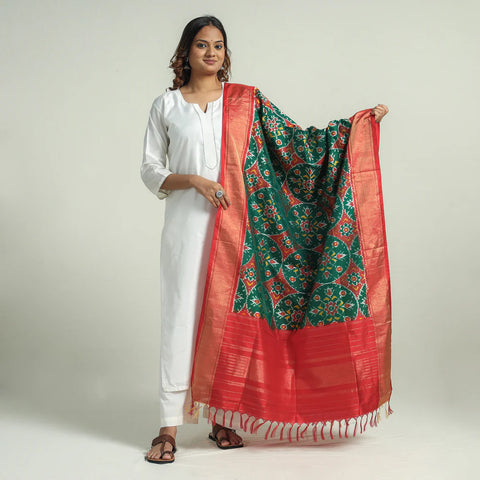
7. Ajrak Dupattas - Rooted in the Sindh provinces of India, this Ajrak hand block art dupatta is made in a lustrous satin fabric with a rich boho vibe - Ageless Ajrak fabric is renowned for its lovely prints, which are primarily combined in intricate patterns. Fabric with ajrak patterns has roots in the Indus valley civilisation, which existed between 2500 and 1500 BC. Three locations—Sindh, Pakistan; Kutch, Gujarat; and Barmer, Rajasthan—produce this distinctive block-printed cloth. Ajrakh cloth is being produced in also produced across other small villages. The technique of creating Ajrakh print cloth is laborious and time-consuming. It is believed that the iron content of the water determines how the fabric will turn out. Making Ajrakh involves several steps.
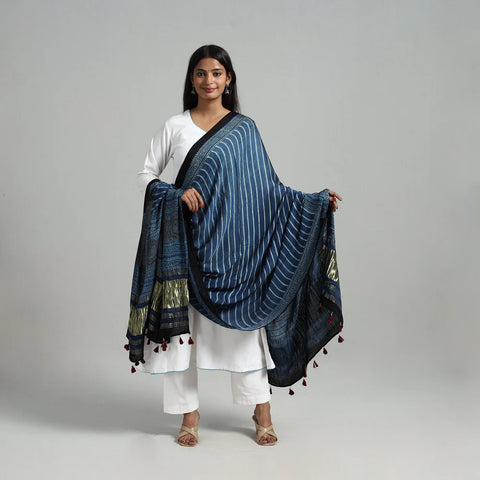
8. Bagh Print Dupattas: Originating from Bagh, a small town in the Dhar district located in Madhya Pradesh, the Bagh Print Art is a traditional kind of Indian art. This traditional technique has been famous for years and is to date looked out by all types of generations. Printmakers from Rajasthan or the Muslim Khatri community, who still perform this traditional print technique, may have introduced the artwork to Dhar. The Bagh pattern has a unique geographical characteristic since the Bagh region is near to the Bagh River, which assists in supplying the water required for cleaning materials and preparing vegetable dyes. Various Bagh Print Dupattas can be found on our website.
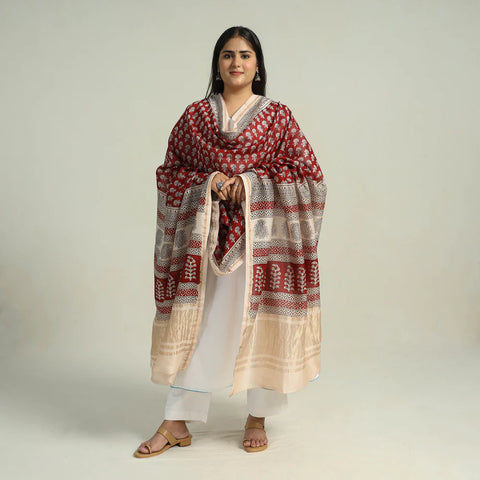
9. Sanganeri Dupatta: Traditional Rajasthani cloth pattern design techniques like Sanganeri hand block printing date back to the 16th century. Historically, a subdued colour backdrop was used to create this stunning and intricate pattern on fabrics, and upon which printed motifs are incredibly elaborated and examined. Firstly, a wooden block is carved and embellished with edges and wrinkles in the shapes of vines, florals, ornate patterns, etc. The following design is then printed mainly across the fabric, which was dyed previously. The result is stunning Sanganeri Dupattas with a lovely and bright background that is detailed with beautiful patterns and motifs.
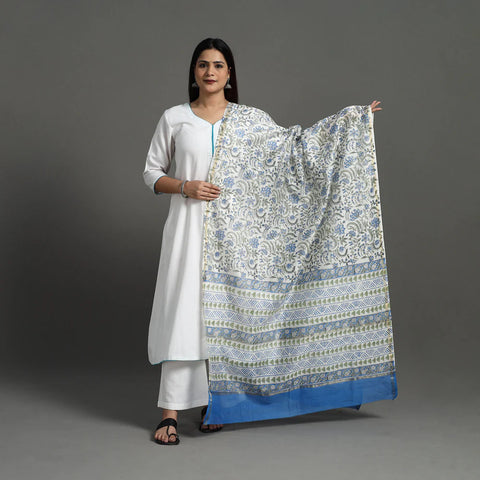
10. Leheriya Dupatta: The traditional tie-dye method known as leheria is used in Rajasthan, India, and produces a vibrantly coloured fabric with unusual patterns. Since this tie-dye printing technique is famous for imprinting intricate wave patterns, the technique's name is derived from the Rajasthani word leher, which means wave. Our chiffon leheriyas are available in various styles, including leheriyas with borders and gota patti. For a joyful ethnic style, wear these Leheriya dupattas with any traditional attire and quirky jewellery.
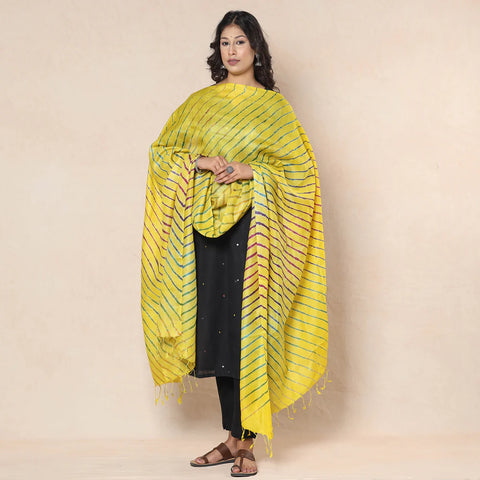
11. Shibori Dupattas: The cloth and dyestuff used in the shibori tie-dye technique are often versatile and simple to handle. A white piece of fabric—typically made of silk, hemp, or cotton—is taken, twisted, clustered, knotted, and wrapped in order to dye it in different natural colors. Shibori tie-dye clothing and apparels are comfy and easy to carry, giving you the most bright and appealing appearance. Browse our extensive selection of designer shibori tye-dye dupattas.
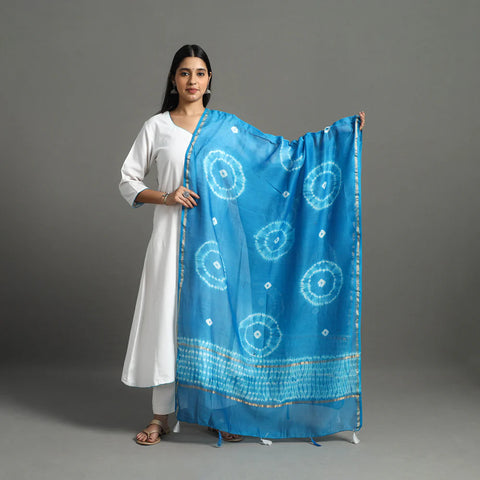
12. Pochampally Ikat Dupatta: Ikat, which translates to "bind" in Indonesian, is a textile patterning technique that originated in Indonesia and uses resist dyeing on the strands before colouring and stitching the cloth. The pattern is neither woven into the structure of the material nor it is to be placed on the upper layer of the finished fabric. Instead, before being dyed, portions of the yarns are covered with a resist. The Pochampally Dupattas are produced in Bhoodan Pochampally and is well-known for its Ikat-style dyeing and traditional geometric patterns.
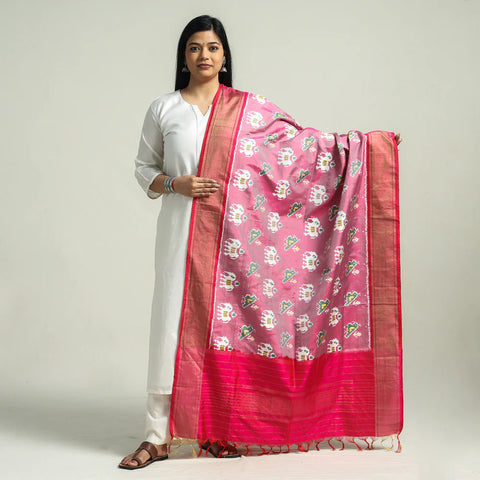
13. Handloom Dupatta: Pure dupattas made from hand-loomed material such as silk, , cotton, etc. are not only beautiful but also light and quite pleasant to wear with traditional attires. These dupattas are incredibly colourful and eye-catching. Our collection of handcrafted dupattas comes in many patterns and hues. Combined with your dress or salwar-kameez suit, a lovely traditional ensemble will result. You can choose any kind of dupatta to give your clothing a touch of grandeur. On iTokri, you can find a broad selection of gorgeous designer handloom dupattas and many other items.
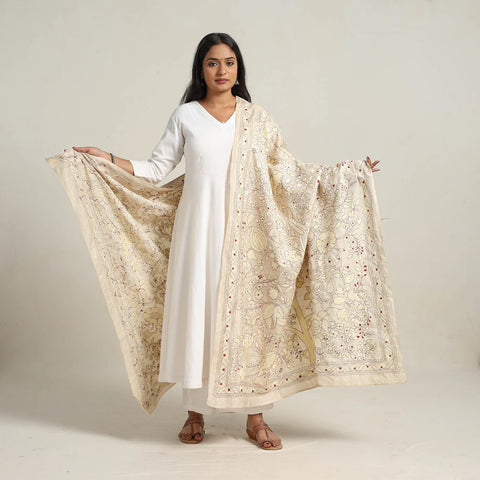
14. Manipuri Dupatta: The well-known Manipuri weave symbolises the Indian state of Manipur's textile weaving industry. The weaving is done entirely manually and is carried out in Manipur by talented tribal and native weavers. Manipuri handloom items come in a wide range of textures and colours. Discover the assortment of stunning Manipuri weave cotton traditional handloom dupattas.
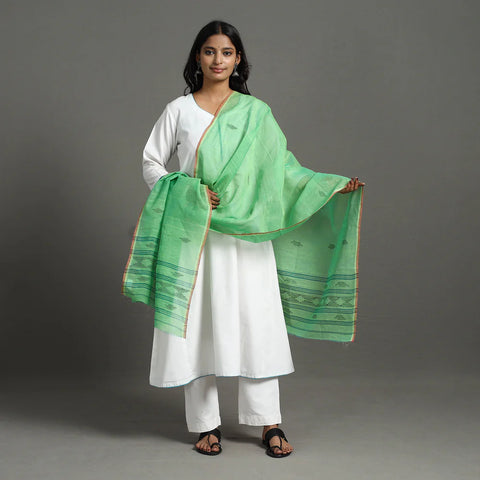
Which Type of Stylish Dupatta for Women is Best?
Every 1990s dupatta has its own charm. You can choose an Indian dupatta in different fabrics and design according to the occasion. For festive outfits or wedding looks you can choose a Banarasi Dupatta or a Chanderi Dupatta. The intricate work and soft feel of silk is a perfect match for any festive wear. For everyday wear you can pick Ajrakh or Sanganeri dupattas made on soft cotton. They are easy to carry and look crisp. For casual wear, you can choose Kalamkari, Ikkat or Pochampalli ones which are stylish dupattas for women.
Apart from the above-mentioned traditional dupatta, you can find many other kinds of dupatta online at iTokri handicraft store. Under each category, we have various types of products that are unique because of their print, texture and colour. We ensure to provide you with a high-quality dupatta that can be paired easily with any outfit so that you can look your best.
Frequently Asked Questions
1.How to wear a dupatta stylishly?
You can easily create the 1990s dupatta look stylishly by trying different draping styles. Try a classis drape with lightweight dupattas where you drape it over the shoulders and let it flow freely. For a modern twist you can try a single-shoulder drape or a cape drape.
Consider the occasion for your ethnic look with stylish dupatta for women. A heavy, embellished dupatta can elevate a simple outfit, while a lighter, flowing one can add elegance to a formal look.
2.How to carry dupatta on kurti?
You can carry Indian dupattas on kurti using various kinds of drapes to create versatile looks. Place your favourite stylish dupatta for women on one shoulder, secure it with a pin and let it flow freely. You can try the classis drape too. For a contemporary twist use a belt to create defined silhouette and add a stylish touch to the look.
 Verified Purchase
Verified Purchase




















































Leave a comment (all fields required)